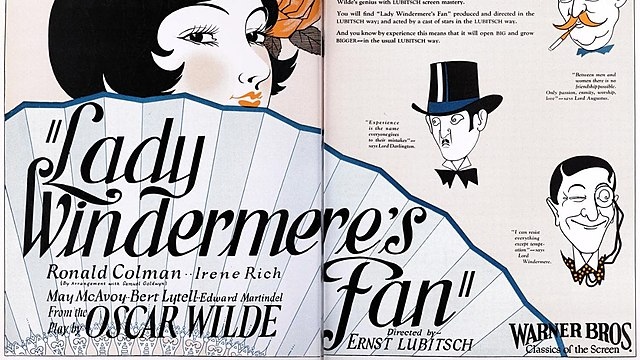october 2023
The ornate architecture of the Vaudeville Theatre in London’s West End transports the audience of the Classic Spring Theater Company’s 2018 production of Oscar Wilde’s first social comedy, Lady Windermere’s Fan, to 1890s London before the show even begins. The house curtain resembles a lady’s unfolded fan, with portraits of society women painted on each pleat. The women hide coquettishly behind fans of their own and silently communicate their thoughts to the theatergoers.“No,” “Yes,” “Wait for me,” “I love you,” “Follow me,” they say, beckoning the audience toward the stage and inviting them to infatuation.
Wilde indeed delivers infatuation in this comedy, which discusses the morality and expectations of men and women in society without losing its playful energy. Residents of a London borough accuse Lord Windermere (Josh James), the title character’s husband, of having an affair with an older woman who fell from status in her youth, Mrs. Erlynne (Samantha Spiro). The gossip spreads quickly within the city and seems to reach every household before it captures the attention of Lady Windermere (Grace Molony)–on the same day she is to host her. As the butler, Parker, excessively enunciates the names of guests as they arrive, the party-goers eagerly await the appearance of the disgraced woman.
During the banquet, the characters’ personalities shine through their evening dresses and tuxedos, which costume designer Paul Wills impressively matches to the time period. The dainty and youthful Lady Windermere wears a simple aquamarine gown that shows how little effort she requires to look beautiful. A young, unmarried guest wears a frilly, feathered dress that attracts attention from the male partygoers and demonstrates her flirtatious nature. And when Mrs. Erlynne enters the room, her sparkling black gown proclaims her refusal to conform–her attire strikingly contrasts the room’s pastel color scheme. She floats between men and perfectly matches their outfits, charging the moments she and Lord Windermere share with tension–she complements his attire better than his wife does. Erlynne is unafraid of interacting with the host, which weakens their desperate claims that they are not romantically involved.
The show truly begins at the end of the second act, when Spiro recites a fiery soliloquy about her fall from the upper class. Wilde’s keen eye for the hypocrisy of aristocracy shines through as the characters’ secrets boil and bubble over, exposing the dirty truth that hides behind the elegance of high society.
The cast succeeds in the eventful third and fourth acts, which include a musical interlude written by director Kathy Burke and performed by cast members Victoria Blunt, Natasha Magigi, Matthew D’Arcy, Benedict Salter, and Jennifer Saunders. Known for her roles as Fairy Godmother in the Shrek movies and Edina in the Absolutely Fabulous television series, Saunders returns to the West End theater in Lady Windermere’s Fan after more than twenty years. She brilliantly delivers her lines as the judgemental yet endearing Duchess of Berwick, who Lady Windermere looks up to as a guide and confidant. Saunders and Molony have a chemistry that mimics one of a grandmother and grandchild, complemented by Molony’s ability to convey emotions through subtle gestures. She effectively communicates Lady Windermere’s relationship anxiety with shakey hands and a quavering voice.
While writing Lady Windermere’s Fan, Wilde engaged in an affair with Lord Alfred Douglas, a wealthy creative sixteen years younger than the playwright. Despite applauding the themes of Lady Windermere’s Fan, Victorian society shunned Wilde for his actions and considered him a “sodomite.” The Classic Spring Theater Company infuses this history into their production of the 1892 play with moments like a stolen kiss between two male servants, which hides within the chaos of the party scene. Though audiences now laugh at this reference, one can imagine the uproar that would occur if it had aired a hundred years ago. In his 1889 essay, “The Decay of Lying,” Wilde wrote that “life imitates art.” In this instance, though, art seems to imitate life.

Leave a comment